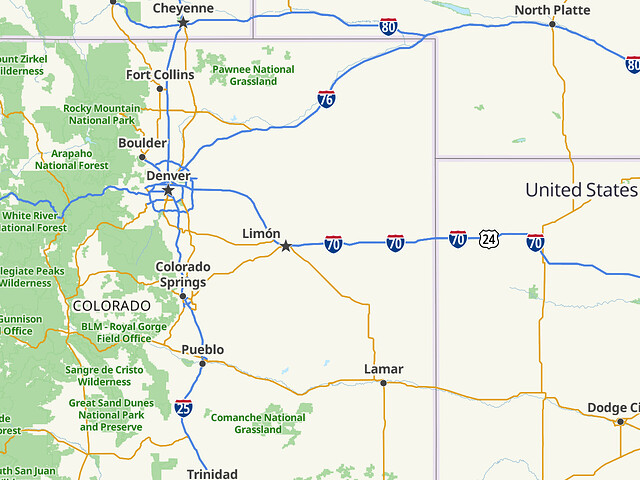Moved from Slack due to length. Had slippy map links for most the examples mentioned, but I’m new to the forum and can’t post more than 3 links right now:
Hi all - pardon the wall of text,
@Joseph R P and I began hashing out a couple disagreements about place classification that I think would be appropriate to put in a more public place than a changeset comment:
1. For suburbanized areas that lie outside of incorporated boundaries and have their own CDP, but otherwise have no clear central governance and aren’t clearly distinct settlements from the incorporated area they abutter, when ought we use town vs suburb?
Spanish Springs, NV is an unincorporated CDP that abutters the incorporated area of Sparks. It lacks any sort of governmental body and the local understanding of where Spanish Springs “is” includes a chunk of the incorporated area of Sparks that it abutters to the south. The given definition for suburb (“A part of a town or city with a well-known name and often a distinct identity.”) seems to describe this best, having lived there for about a decade. In every way except for the incorporation boundary, Spanish Springs exists more as a part of Sparks rather than a distinct place. Joseph argues though that because this area lies outside of the incorporated boundary of Sparks, it is a distinct place and ought to be tagged as a town; even if some people don’t see it as a “distinct” place, peoples understanding of where a “place” exists is often too inconsistent to be useful and so we ought to defer to something more authoritative when it’s available.
Other similar examples of this where I would probably tag suburb rather than town (many of these places might have a general improvement district or a large HOA providing some form of governance, to be clear, but none are incorporated or have anything that acts like an “incorporated” authority) - is my understanding off base?:
*Sun Valley as a part of Reno, NV
*Gardnerville Ranchos as a part of Gardnerville, NV
*Altamont as a part of Klamath Falls, OR
*Spring Creek as a part of Elko, NV
2. In large low-population-density rural areas like most of Nevada, how much does the rural context imply that we ought to raise settlements up the classification hierarchy? Reading both the generic place definitions as well as US specific classification guidelines, it appears much of rural NV is over-classified - but is this appropriate given how few people live in the rural parts of the state?
Fernley, NV was tagged by Joseph as a city on the argument that it’s one of the “principal cities” of the CSA it is a part of and that it’s significantly more populated than nearby towns like Dayton and Fallon.
However, Fernley’s incorporation boundary is significantly larger than Fallon’s and thus the population will measure higher. Fallon has a pretty small incorporated area and there is no abutting CDP to measure the population outside of its boundary. Guesstimating off satellite imagery, if Fallon’s boundary were as large as Fernley’s, the population difference between the two would likely be fairly negligible, but this is just a guess.
At a glance, in terms of size, character, and amenities available, Fernley fits better with the towns in the state (pre-Joseph classification changes) like Minden/Gardnerville, Fernley, Winnemucca (and in the greater region, Truckee, South Lake Tahoe, Susanville) than it does to the clear-cut citys like Reno/Sparks, Carson City, Las Vegas.
Fernley is too close to Sparks to be eligible for this classification “boost” that we’re considering for more remote places. I’d give this “boost” to Fallon before Fernley, given that Fallon is pretty similar in size and amenities offered, but is in a more remote part of the state.
Given the definitions and guidelines above, it seems like Winnemucca, Ely, Fernley being classified as city is too high, with Elko being maybe just right on the cusp. Ely and Winnemucca, though anchor settlements for their regions of the state, could hardly be considered metropolitan areas. This would also imply that places like Lovelock, Battle Mountain, Carlin, Wells, Eureka are classified too high as town, which I’d agree with given the other towns discussed above. However, most of these settlements are the only significant population centers for 50-100 miles, and even the smaller towns have a decent range of services relative to their population because of this. Does it make more sense to see rural NV as a collection of distant villages and towns, or to promote these places higher than they would be somewhere else given the huge distances between settlements and low population density? I lean towards the former argument personally, even given the US-specific guidelines mentioned above.
3. How authoritatively does a CDP define a “place” in the OSM sense? Joseph, in line with the logic mentioned in part 1, has been adding a place=village marker for every CDP with a population over 100 in rural CA and NV. My understanding is that treating CDPs as an authoritative database of distinct places is putting the cart before the horse - CDPs are created by looking for population clusters outside of incorporated areas and pulling a name from some form of local understanding of the area, for the purpose of being able to do better statistical analysis of the US population. A CDP doesn’t necessarily declare something a distinct “place” as we’re using it in OSM.
Some examples of strangeness this is leading to:
Named, low-density residential subdivisions in rural-ish areas are being classified as distinct villages when they more-so belong to a nearby place. Some examples:
*Lakeridge, Skyland on the east shore of Tahoe are more neighborhoods of Zephyr Cove (where they address to as well) rather than distinct settlements.
*Ruhenstroth is a rural neighborhood of Gardnerville and not a distinct settlement, whose name is not posted anywhere and is largely unknown outside of assessor maps and a local Nextdoor.
CDPs with two distinct settlements that are clustered together (like Chilcoot-Venton) end up with a place marker for a place that doesn’t actually exist.
Using population cutoffs only to differentiate between hamlet and village is leading to small, distinct places like Cedar Flat, CA (N Lake Tahoe, has it’s own state-designated place sign on the highway) that have zero commercial services being misclassified according to those guidelines above. (ie, a distinct place with <1,000 population and zero services should probably be tagged hamlet)


